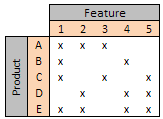(or: “If Paradigm was half as nice”)
 I started reading Coders At Work recently. In the style of a few predecessors, the book comprises transcribed (and presumably edited) interviews with fifteen programmers who have made significant contributions of various kinds. It’s a weighty tome, possibly a little overweight if I’m honest, but interesting nonetheless; it makes a change from the kind of technical tome I usually cart around on the daily commute.
I started reading Coders At Work recently. In the style of a few predecessors, the book comprises transcribed (and presumably edited) interviews with fifteen programmers who have made significant contributions of various kinds. It’s a weighty tome, possibly a little overweight if I’m honest, but interesting nonetheless; it makes a change from the kind of technical tome I usually cart around on the daily commute.
Circling a little closer to, and nodding vaguely in the general direction of the point, interviewee number seven, reached just this morning, is Simon Peyton Jones, who was one of the progenitors of Haskell, one of, if not the first name that springs to mind when one hears “functional programming“. For the last decade, Jones has been a researcher at Microsoft Research in Cambridge, which suggests that he would have had at least one finger in the F# pie… There’s a DotNetRocks show number 310 features an interview with the man, by the way. I’m enviously disturbed that despite our very similar ages, he appears considerably less follicly-challenged than me, although there could be some comb-over action going on there.
In the taxonomy of programming paradigms (does that make sense?) we have Declarative and Imperative. They are opposites. In the Declarative fold, we get stuff like SQL, XSLT, all the functional languages and, I submit Excel worksheets. Actually it’s not just me: that Wikipedia link places spreadsheet cell-based programming within the Dataflow subcategory of Functional. Imperative programming, on the other hand, includes the panoply of more “traditional” languages, including good old Visual Basic and its slightly less functional sibling VBA.
Thinking about Excel and VBA developement, I’d say there are several fairly distinct uses for VBA code (usually, but not exclusively: we can write add-ins or perform automation in plenty of other ways) which include:
- New worksheet functions;
- Interface extensions (menus, toolbars, ribbons etc);
- Helpers (or wizards);
- Control and simulation
…of which I write a lot of the latter two.
 (You know how some comedians talk about a string of seemingly unrelated things and then cleverly tie them all together at the end? Well, fingers crossed, stay tuned)
(You know how some comedians talk about a string of seemingly unrelated things and then cleverly tie them all together at the end? Well, fingers crossed, stay tuned)
A while back, I was handed a workbook, developed by an external consultancy, that modelled the 20-year evolution of a financial product. We wanted to run it across a significant number of stochastic market data simulations to get a picture of the distribution of possible outcomes. About 30,000 such simulations (and about 16GB of simulated market data) would be sufficient, we thought. The workbook took about 20 minutes to perform one such calculation. We didn’t have a year.
Fortunately, there were any number of classic optimisation failures to rectify: massive VBA/worksheet interaction at the cell level (changed to use large arrays), screen update enabled at all times, lots of less painful VBA-specific stuff, Application.Calculation = xlCalculationAutomatic, you know the drill. Easy stuff. Within a day it was taking about a minute and I could look at having the whole analysis done in under a week (I have a four-CPU machine).
If it all seems straightforward, it wasn’t. I’d wrapped the workbook in a modified (hacked-up from xlUnit) test jacket to check that my changes weren’t affecting the results, pretty much a necessity for any refactoring work, and one change kept breaking. Every time I tried to switch off automatic calculation, triggering it only when I thought it was needed, the final results came out different. I finally realised that the VBA and worksheet were extremely highly-coupled – calculations were occurring as the code pushed values through: change a value, auto-calc, change another value, auto-calc again and so on. Eek. It took almost a week to unravel. Of course, since I actually enjoy doing this kind of work for the most part, it wasn’t a complete disaster, but I could have lived without the time pressure…
As a finance worker (perversely, I’m increasingly inclined to describe myself as a Banker1 these days) I have cause, from time to time, to access The Bloomberg from Excel. At least one of the functions in the (extensive and powerful, let’s be fair) API is a real functional-imperative mess. Here’s one with which I’m not at all happy:
=BDH("MXWO", "PX_LAST", "01/06/2007", "28/12/2009", "Dir=V", "Dts=S", "Sort=A", "Quote=C", "QtTyp=Y", "Days=T", "Per=cd", "DtFmt=D", "cols=2;rows=672", "FX=EUR")
Yes, there are a lot of arguments2, but most are at least not positional, which shows they’re trying. This particular example asks for the last daily quote of the MSCI World Index, in Euro, between the dates given. Even better, I guess, there’s a wizard to generate it all for you. But here’s the nasty bit: the call fills as many rows – without warning about overwrites – as it needs. Oh, and that "cols=2;rows=672" parameter? It’s rewritten if you make any change that would affect the number of cells output. This is not easy to accomplish. Try duplicating the effect in VBA, go on, I double-dare you. I think there’s a separate server process at work here, able to make asynchronous (but timely) modifications to user worksheets.
Yikes. And ugh.
To me, there’s something broken here. They’re using am apparently functional programming model but allowing the code to affect the state of the worksheet in (from the user’s perspective at least) a rather arbitrary (or at least, unpredictable) way. We’re not even getting an array formula here – the function just causes chunks of worksheet to be filled with data. In point of fact, there looks to have been some serious programming work here – I don’t think in the normal course of events that calling a function is allowed to cause areas outside the calling range to be modified. I rather suspect an external process is being asked to pump values into the sheet through some devious means like (but let’s hope it isn’t) DDE.
(This is where I try to pull it all together. A little encouragement wouldn’t go amiss here…)
The fact that we have both paradigms represented as first-class components of a single development platform may be a large part of the reason for Excel’s dominance in the marketplace. But the interface between declarative and imperative code needs to be carefully managed to avoid the kind of unnecessary side-effects that I spent so long untangling.
The messed-up simulation I whined about above failed to recognise that the worksheets should have been, in effect, a great big, super-complex function, which the code used by setting up the input conditions, firing off a Calculate and then reading the output values. Instead, it tried to implement a tightly-coupled declarative-imperative abomination, with unfortunate results.
Let’s try not to repeat that mistake, for the sake of the children.
I’ve been (and remain) grumpy – thank you and good night.

1 Wanna make something of it?
2 Many Reuters functions do something similar, but push all the key-value pairs into a long string.


















